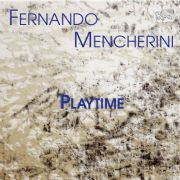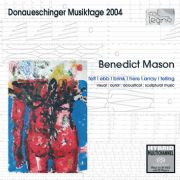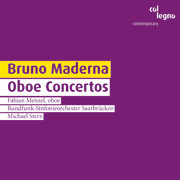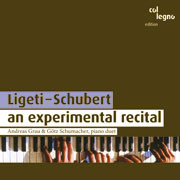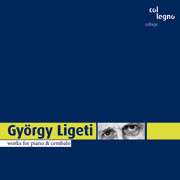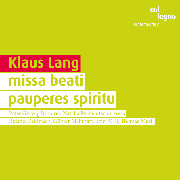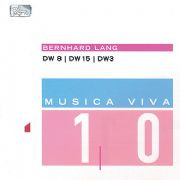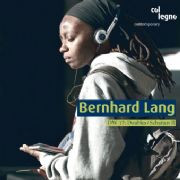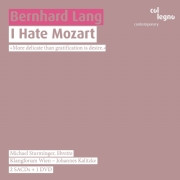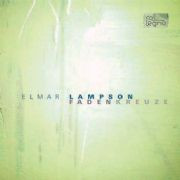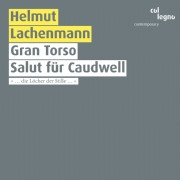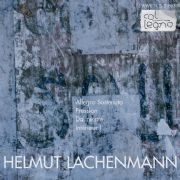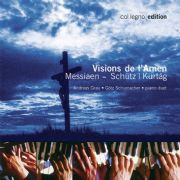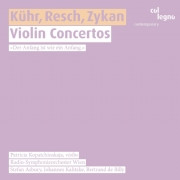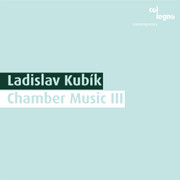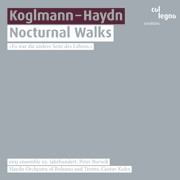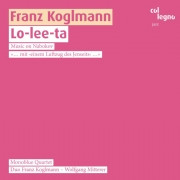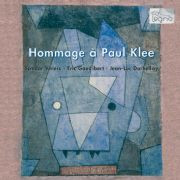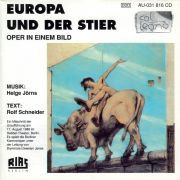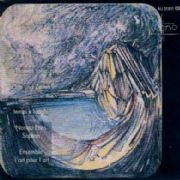Playtime
Including Notturno volgare, for clarinet; Playtime No.1; Alex in Mongolia, for two guitars; Rite in progress, for piano; Notturno, for double bass; Playtime No.4; Dietro l'orologio, for soprano & tenor saxophones; Sei danze, for violin.
Donaueschinger Musiktage 2004
Unusually, the 2004 annual COL LEGNO release from the Donaueschinger Musiktage is devoted to the work of one composer, Englishman Benedict Mason, and to just one extensive and curiously-titled work, commissioned in 2001 by the German Südwestrundfunk. Specially written for the hall in Donaueschingen where this live recording of the work’s first performance was made, Mason’s music explores space and acoustic, as well as the character of a variety of instruments, to fascinating effect.
Oboe Concertos
The oboe more than suited Maderna's partiality for clear structures and sensual-concrete sounds. It was not without good reason that at a time when the supply of music dedicated to the oboe was anything but plenty, Maderna wrote, not one, not two, but three concertos (besides several other works for oboe) for this "nasal" sounding member of the woodwind family. The first oboe concerto (1963) seems almost classical in its character, in the interplay of oboe and orchestra, or involving other instr…
An Experimental Recital
Some 150 years apart, both composers developed minute nuclei into an ever expanding cosmos of sound, each against the background of his own era. Prick up your ears – Schubert's Fantasy in F minor and Sonata in B flat major D 617 crossed with Ligeti's Three pieces for two pianos: rich in contrasts, upsetting, and in a simply stunning interpretation by Andreas Grau & Götz Schumacher. In the beginning there was simply the idea of playing Schubert and Ligeti together in one program: "During the perf…
Works for Piano and Cembalo
The pieces for piano/cembalo on this CD include the first two Capriccios by the 24-year-old Ligeti, the Musica ricercata, and the first volume of the legendary Études, in brilliant interpretations by the German pianist Erika Haase. Ligeti was a master in how to make tricky compositional systems appear as more than just that by inspiring them with sensual substance: that's what distinguishes the artist from the artisan. Throughout his life Ligeti kept his ears pricked up and his senses sharpened …
missa beati pauperes spiritu
In cooperation with IEM Graz and musikprotokoll 2005 (steirischer herbst, ORF). Excursion into the Middle Ages: Klaus Lang’s latest composition breathes new life into Gregorian chant more than a thousand years old. One hears the traditional sequence of the mass movements, but newly composed material gives it a new interpretation. Klaus Lang does not wish to evoke images in his listeners but rather empty and impoverish their minds.
Musica Viva 10
“The first pieces of the Differenz/Wiederholungs-Serie were composed by transcribing loop techniques of different turntable lists and filmmakers … What appealed to me especially was the concept of erratic, asymmetric loops corresponding to the crack in the groove or to the trembling of a malfunctioning CD player.” This idea has already spawned many parts of the DW, which bring to the fore a great variety of different phenomena of our noisy, sound-generating lives. In DW 8, the orchestra, “like t…
DW 17: Doubles / Schatten II
The unfolding of the differences is succeeded by ever new ramifications, versions, series. DW 17 Doubles/Schatten II as a new phase in the DW-Kosmos.
I Hate Mozart
"Why do I have to sing Mozart all the time?", the tenor in Bernhard Lang's opera "I hate Mozart" cries out in despair. Well, why always listen to Mozart operas and not an opera of the early 21st century for a change? With their provocatively named contribution to the Viennese Mozart Year 2006, composer Bernhard Lang and librettist Michael Sturminger succeeded in creating a parody of the opera business that loses none of its sharp wit in the CD recording. The "backstage insights" supplied on DVD …
FADENKREUZE
For Elmar Lampson, composition and the phenomenology of music overlap as disciplines, and attentive listening is as critical to his works' reception as is analysis of their carefully timed structures or pitch content. Lampson's String Quartet No. 2 (1992-1998) operates on several aural planes, some near and easy to distinguish, and others more remote and indistinct. The material shifts between active, atonal flurries and soft, almost lyrical passages of modal simplicity, and the extremely soft d…
Gran Torso / Salut für Caudwell
In 1988 the first issue of these recordings of Gran Torso and Salut für Caudwell was awarded the Preis der Deutschen Schallplattenkritik (German Record Critics' Award); and neither compositions nor recordings have lost any of their value up to today. In Gran Torso, Lachenmann tried to explore the “mechanic and energetic conditions of sound production”. This resulted in singular, unusual sounds which simultaneously exploded the barriers of audibility, playing technique and sound as such. The guit…
Allegro Sostenuto / Pression / Dal Niente / Intérieur I
Both Sostenuto and Dal niente were composed for the clarinetist Eduard Brunner. “As in the earlier Ausklang for piano and orchestra, the musical material is determined by the interplay of the experiences of resonance on the one hand and motion on the other. Both aspects of sound encounter one another in the conception of structure as a multiply ambivalent ‘arpeggio’, i.e. as a process of construction, deconstruction and reconstruction – experienced in temporal succession – which is conveyed both…
Visions de l\'Amen
Last things and Christian visions: György Kurtág's reflections on Heinrich Schütz, and Olivier Messiaen in search of the "Amen."
Violin Concertos
The exceptional violinist Patricia Kopatchinskaja not only impresses audiences and critics – she also inspires eminent composers like Kühr, Resch & Zykan.
Chamber Music 3
Composer Ladislav Kubík was born and educated in Prague. In 1991 he began teaching at Florida State University, and the performers on this CD are drawn from the FSU community. The pieces collected here were written in the first years of the twenty-first century and include instrumental music and Songs of Zhivago, a substantial song cycle for tenor and piano. The cycle consists of six of Pasternak's poems in English translation. Kubík's atonal harmonic language tends toward academic grayness (a p…
Nocturnal Walks
The truth is out: Haydn was a jazz composer! Franz Koglmann took the diligent classic's 27th symphony with him on his Nocturnal Walks.
Lo-lee-ta
Vladimir Nabokov: the master of "chamber music in prose" (literary critic Marcel Reich-Ranicki) and composer of crackling word sonatas. Franz Koglmann: a commuter between jazz/avant-garde and literature, and writer of intimate sound novellas. It was only a matter of time before Koglmann would create "Music on Nabokov," and transform literary motifs and characters into music. Together with his Monoblue Quartet (Tony Coe, clarinet/saxophone, Ed Renshaw, guitar, Peter Herbert, bass) the trumpeter K…
Hommage à Paul Klee
With his Pedagogical Sketchbook often regarded as a virtual manual in composition, Paul Klee has exerted a far-reaching influence on modern music. Few composers were so profoundly affected as Sándor Veress, whose encounter with Klee's work after fleeing Hungary in 1949 gave rise to seven fantasies that range from the Bachian gravity of 'Old Sound' and the intensely elegiac 'Green in Green' to the rhythmic playfulness of 'Stone Collection'. Grau and Schumacher give a committed performance, differ…
Europa und der Stier
Myths are human experiences congealed into fables. Rolf Schneider, expelled from the GDR Writers' Association in 1979, presents the story of Europa and the bull as a dirty joke, a great comical love story, the story of a girl used and discarded by a macho, a defeat with a disastrous outcome. Composer Helge Jörns has clothed the plot in chamber music of an aggressive clarity, developing the – both logical and precise – formal division with exceptional skill out of the dramatic requirements: "Form…
Orte und Zeiten/Tempi e Luoghi
While traveling through time in Italy and Germany, Thomas Jahn was particularily intrigued by the “culture of resistance”. The poems underlying the cycle are all concerned with resistance – resistance against war, against the lack of affection and against inhumanity: “He finds its remnants, so prevalent in Italian folklore, also in German lyric poetry.” (Hans-Werner Heister) Some of the texts alternate between German and Italian, sometimes even within the space of a single phrase or word. The pr…
